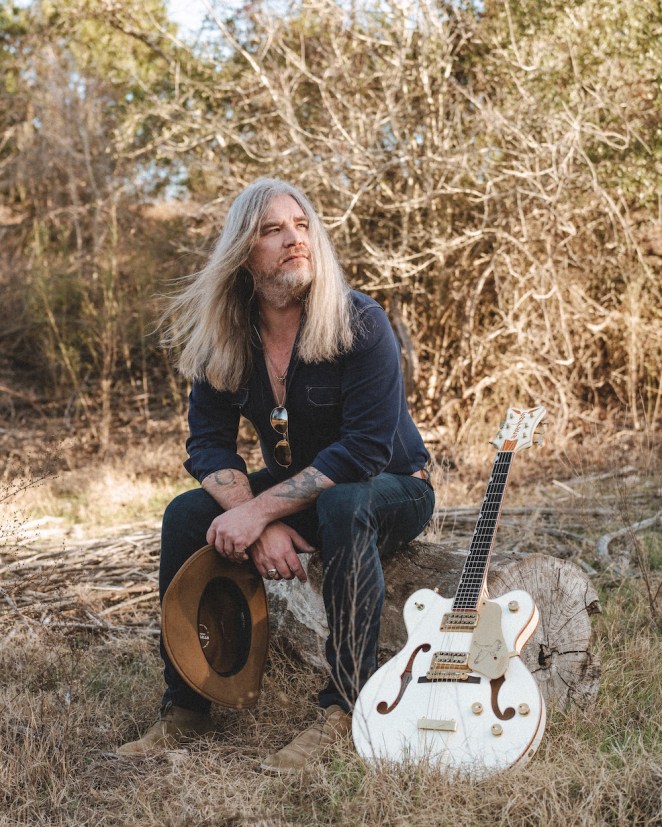Born and raised in Aurora, Missouri, Israel Nash began digging up more of his Ozark origins. There was a relative on his mother’s parents’ side who changed their name to remove any association with 19th-century outlaw Jesse James. “They changed it from James because of the James Gang in Missouri at that time so it was always a legend there was somehow related in some way to Jesse James,” Nash tells American Songwriter. “Everyone in that area says they’re related to Jesse James,” he laughs. “He was such a legendary outlaw.”
Videos by American Songwriter
Remembering other fragments of old stories he heard growing up and documenting more his mother shared with him, Nash set up in a rented space along the Blanco River, in Kendall County, Texas, and began sifting through the people, places, and stories of his ancestry and second-hand accounts. Equipped with a guitar, drum machine, Casio keyboard, and four-track record, Nash captured 10 stories of Ozarker.
Produced by Kevin Ratterman (My Morning Jacket, Ray LaMontagne) and recorded with Bright Light Social Hour guitarist Curtis Roush, Floating Action’s bassist Seth Kauffmann, and My Morning Jacket drummer Patrick Hallahan, along with Eric Swanson on pedal steel, Ozarker opened pieces of Nash’s past that all linked to his present-day life.
Ozarker isn’t a romanticized rendering of the Ozarks or life therein in the 19th or early 20th centuries or a collection of musical ephemera. Nash’s stories are colored by honesty and empathy for those who came before him.

Animated by the more adventurous movement of “Can’t Stop” and “Roman Candle,” the soulful title track recounts the story of Nash’s migrant great-grandfather who fell in love with the daughter of an orchard owner and returned to marry her after a year had passed.
Exploring nearly every genre since his 2009 debut New York Town, Nash fills in more of a heartland rock gap on Ozarker with the cinematically driven “Pieces,” the anthemic “Going Back, and “Lost In America” recounts the story of a family friend who struggled to recover post-Vietnam.
“Midnight Hour” slips into some E Street Band rush through the closing “Shadowland” covering the ominous cycle of rural Missouri poverty and drug addiction.
Like most of his albums, Ozarker was something Nash specifically sought out. Typically working out of his home studio in Dripping Springs, Texas, the space has helped shift his songwriting for the better throughout the past six or seven years. Albums and writing are more immediate and omnipresent.
“I don’t wait around for a new album,” shares Nash. “I’m always seeking a record or seeking a project. Having the space and instruments and being able to record and create any time changes the dynamic. When I first made records, I’d have this batch of songs and go into a studio, but this is more like a living thing.”
Constantly living within the stories now, Nash also worked through his previous album, the more psychedelic-bent Topaz, during the pandemic before he started gathering the pieces for Ozarker.
“It just allows me to go through different genres and scratch the itch that I’m having, sonically,” says Nash. “Searching for ‘Ozarker’ I just wanted to make something more mainstream rock and roll. There have been so many tributaries [of music] that have gained popularity over the years, and it’s a beautiful map of water, but I just wanted to make rock songs and share these common stories we all have in our history that shape us and bring us to where we’re at.”
Nash adds “Hopefully we tell some of those stories to people and they’re telling our stories in 100 years.”
Traveling back in time to the Ozark past was just another sonic documentary for Nash, which actually started with an interest in an older story rooted in Texas history, and a fascination with the Newtown Gang, the early 20th-century outlaw brothers, who became the most notorious bank and train robbers in history.
“I had this producer on my first album that told me that they call it an album or a record because it’s a record of time,” says Nash. “We don’t think of it necessarily like that, but it’s like a photo album of sonic pictures. When we have a picture in a photo album, it’s of people or places, and a lot of these songs were stories that I remember growing up.”

These stories, and pictures, are something Nash has been trying to connect to fans in the live setting and encouraging them to share their own stories. “We all came from something, and I want to empower that thought even deeper than my own stories,” he says. “Our stories are important, and that’s ultimately what songwriters do, they document the times. It’s just another medium.”
Throughout the past decade the industry has shifted, particularly since the pandemic from live music to recorded music and even journalism, says Nash, which has left some stories and storytelling, in the backseat. “Everything has been affected in our music ecosystem,” says Nash. “The power that some of our industry, and some of this genre had one time were the gatekeepers, if you will, or those stronger voices and soap boxes that help inform listeners.”
Playing a series of pop-up shows in Europe, Nash limited tickets to 20 in attendance and shared some narratives around the songs on Ozarker before encouraging audience members to share their own stories. “Communicating some of these stories before playing them has been profound,” shares Nash. “They can connect more intimately to them. People were telling me these intimate stories about how music or certain records affected their lives so powerfully. Even more so since the pandemic, it’s powerful to get back to connecting to people in a room.
Music is one of those things that does that in the real world. There’s still such power in that. It’s just in our DNA.”
Photos: Chad Wadsworth / Courtesy of Clarion Call Media
